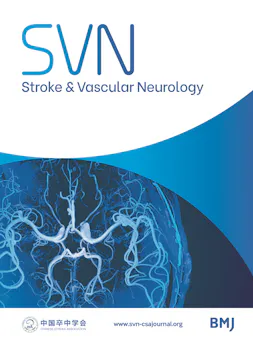Intelligent cholinergic white matter pathways algorithm based on U-net reflects cognitive impairment in patients with silent cerebrovascular disease
IF 4.9
1区 医学
Q1 CLINICAL NEUROLOGY
引用次数: 0
Abstract
Background and objective The injury of the cholinergic white matter pathway underlies cognition decline in patients with silent cerebrovascular disease (SCD) with white matter hyperintensities (WMH) of vascular origin. However, the evaluation of the cholinergic white matter pathway is complex with poor consistency. We established an intelligent algorithm to evaluate WMH in the cholinergic pathway. Methods Patients with SCD with WMH of vascular origin were enrolled. The Cholinergic Pathways Hyperintensities Scale (CHIPS) was used to measure cholinergic white matter pathway impairment. The intelligent algorithm used a deep learning model based on convolutional neural networks to achieve WMH segmentation and CHIPS scoring. The diagnostic value of the intelligent algorithm for moderate-to-severe cholinergic pathway injury was calculated. The correlation between the WMH in the cholinergic pathway and cognitive function was analysed. Results A number of 464 patients with SCD were enrolled in internal training and test set. The algorithm was validated using data from an external cohort comprising 100 patients with SCD. The sensitivity, specificity and area under the curve of the intelligent algorithm to assess moderate and severe cholinergic white matter pathway injury were 91.7%, 87.3%, 0.903 (95% CI 0.861 to 0.952) and 86.5%, 81.3%, 0.868 (95% CI 0.819 to 0.921) for the internal test set and external validation set. for the. The general cognitive function, execution function and attention showed significant differences among the three groups of different CHIPS score (all p<0.05). Discussion We have established the first intelligent algorithm to evaluate the cholinergic white matter pathway with good accuracy compared with the gold standard. It helps more easily assess the cognitive function in patients with SCD. Data are available upon reasonable request.基于 U-net 的智能胆碱能白质通路算法能反映沉默型脑血管病患者的认知障碍情况
背景和目的 胆碱能白质通路损伤是伴有血管源性白质高密度(WMH)的沉默性脑血管病(SCD)患者认知能力下降的基础。然而,胆碱能白质通路的评估非常复杂,一致性较差。我们建立了一种智能算法来评估胆碱能通路的 WMH。方法 入组具有血管源性 WMH 的 SCD 患者。胆碱能通路高密度量表(CHIPS)用于测量胆碱能白质通路损伤。智能算法使用基于卷积神经网络的深度学习模型来实现WMH分割和CHIPS评分。计算了智能算法对中重度胆碱能通路损伤的诊断价值。分析了胆碱能通路 WMH 与认知功能之间的相关性。结果 464 名 SCD 患者被纳入内部训练集和测试集。利用由 100 名 SCD 患者组成的外部队列数据对算法进行了验证。在内部测试集和外部验证集中,智能算法评估中度和重度胆碱能白质通路损伤的灵敏度、特异性和曲线下面积分别为 91.7%、87.3%、0.903(95% CI 0.861 至 0.952)和 86.5%、81.3%、0.868(95% CI 0.819 至 0.921)。一般认知功能、执行功能和注意力在 CHIPS 分数不同的三组之间存在显著差异(均 p<0.05)。讨论 我们首次建立了评估胆碱能白质通路的智能算法,与金标准相比具有良好的准确性。它有助于更轻松地评估 SCD 患者的认知功能。如有合理要求,可提供相关数据。
本文章由计算机程序翻译,如有差异,请以英文原文为准。
求助全文
约1分钟内获得全文
求助全文
来源期刊

Stroke and Vascular Neurology
Medicine-Cardiology and Cardiovascular Medicine
CiteScore
11.20
自引率
1.70%
发文量
63
审稿时长
15 weeks
期刊介绍:
Stroke and Vascular Neurology (SVN) is the official journal of the Chinese Stroke Association. Supported by a team of renowned Editors, and fully Open Access, the journal encourages debate on controversial techniques, issues on health policy and social medicine.
 求助内容:
求助内容: 应助结果提醒方式:
应助结果提醒方式:


